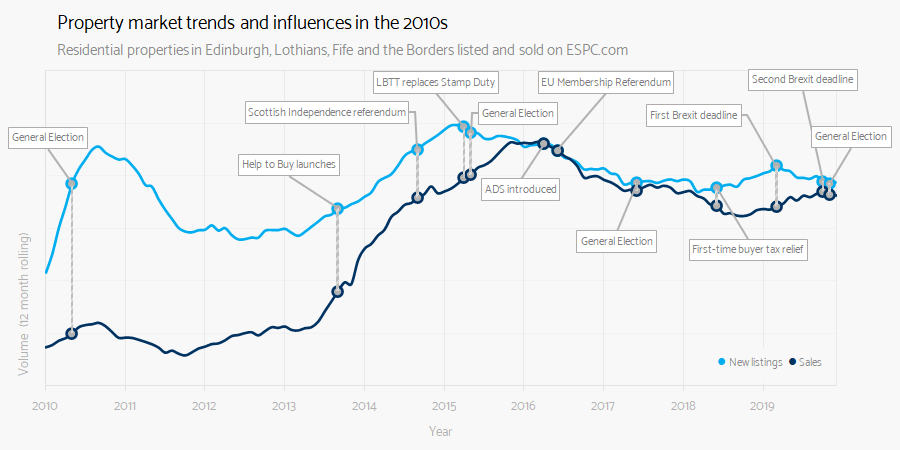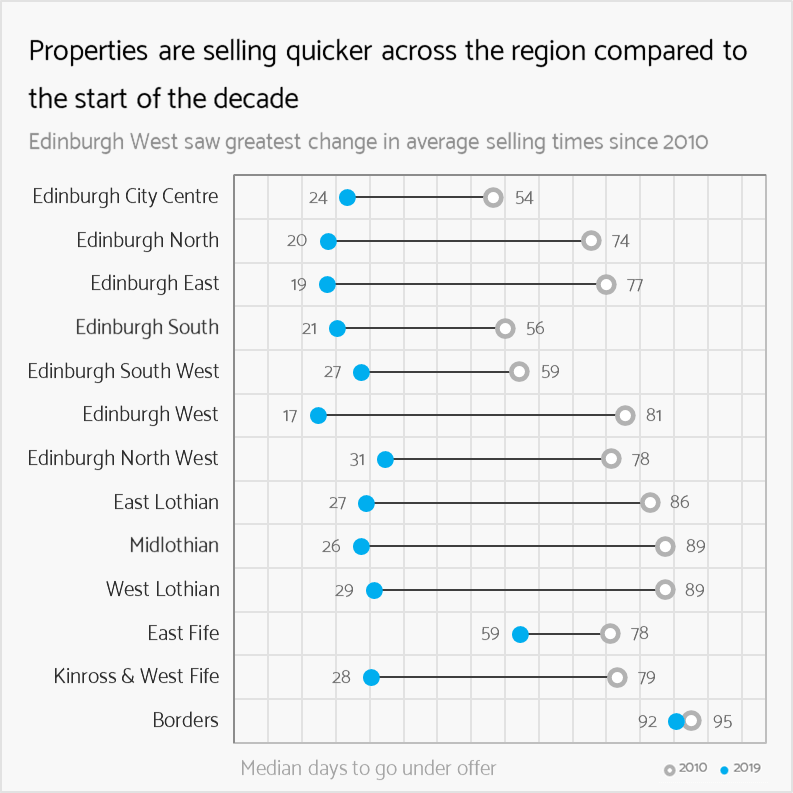How has the property market changed over the past decade?
In this article, key statistics about the property market in Edinburgh, the Lothians, Fife and the Borders illustrate just how much the market has changed over the last ten years and the potential factors that have influenced it, from Brexit to the ‘Beast from the East’.
Key property market statistics from 2010 - 2019
- Over the decade, the average selling price in Edinburgh, the Lothians, Fife and the Borders increased by 23% from £206,144 in 2010 to £253,467 in 2019
- The number of homes coming to market in 2019 was 5.2% lower than the volume in 2010
- The volume of sales increased by 55% between 2010 and 2019
- The average asking price for residential properties grew by 17% in ten years, from £202,473 in 2010 to £237,529 in 2019
- The median time for properties to go under offer significantly decreased, from 71 days in 2010 down to 22 days in 2019.
Sales volume and number of homes coming to market in the 2010s
The decade began on an upward trend with an increasing number of homes coming to market, rising to a peak in 2015. Meanwhile, buyer activity was slow for the first half of the decade, with a marked increase in competition and demand since 2015.

The first months of 2010 marked the initial signs of seller confidence after the financial crisis of 2008. Buyer confidence had yet to peak, with many homes coming to market and later being retracted, unsold.
This growing recovery stalled by 2011, as the market entered two years of receding volumes of homes coming to market, as the buyer market continued to show little sign of increasing confidence.
Demand from buyers escalated sharply from mid-2013, around the time of the Help to Buy scheme launching, making the process more accessible for first time buyers. It could be that a growing buy-to-let market also contributed to this demand. This demand continued a steady upward trend until the months leading up to the EU Membership Referendum of 2016.
This period also coincided with the introduction of the Additional Dwelling Supplement; a tax payable by buyers purchasing a home in addition to one they already own. Demand remained high for the rest of the decade, easing slightly in 2018, but again returning to strong demand levels by the end of the decade.
The volume of homes coming to market peaked in 2015 and entered a subsequent slowdown from 2016 which continued for most of the rest of the decade. The start of the slump in new market insertions occurred around the time the Land and Buildings Transaction Tax (LBTT) replaced Stamp Duty for property sales in Scotland. A slight increase in volume occurred in 2018, but the high watermark levels of activity seen in 2015 remained unchallenged.
A notable external influence which did not come from either the political or economic spheres took place in February 2018. The ‘Beast from the East’ caused unseasonably low temperatures and heavy snowfall to much of the UK. Locally, the time period affected by the Beast from the East correlated with a 2.4% drop in volume of homes coming to market in March 2018 compared to the previous year.
The decade closed with a sharp drop in sales volume trend, potentially due to the regular winter slowdown being compounded by public focus on the fourth UK General Election in a decade.
Comparing the first year of the decade to the last for the whole of Edinburgh, Lothians, Fife and the Borders, the volume of homes coming to market has decreased by 5.2%, while the number of properties sold has increased by 55%.
Average property selling prices increase across the region
The average selling price in Edinburgh, the Lothians Fife and the Borders in 2019 was 23% greater than 2010, increasing from £206,144 to £253,467. East Fife experienced the greatest percentage growth in average selling prices, with a 63% increase over the ten year period.


Homes selling faster in Edinburgh, the Lothians, Fife and the Borders
The median time to sell homes in Edinburgh, Lothians and Fife decreased by 49 days, from 71 to 22 days. Most regions within Edinburgh, Lothians, Fife and the Borders saw significant decreases in the average number of days taken to sell homes. Edinburgh West ended the decade with the quickest time to sell, with properties going Under Offer in a median time of just 17 days, down from 81 days at the start of the decade.

ESPC moves into the 2020s
Over the decade, ESPC and our member solicitor estate agents have:
- Listed more than 100,000 properties for sale across Edinburgh, Lothians, Fife and the Borders
- Sold more than £19 billion worth of residential property across Edinburgh, Lothians, Fife and the Borders
- Served more than 990 million pageviews to property hunters and sellers on ESPC.com
- Provided a wealth of content on espc.com which buyers and sellers have spent over 1,300 years' worth of time looking at.
Over the past ten years, there have been many changes at ESPC. We have expanded the areas we advertise properties in to include the west of Scotland and Dumfries and Galloway.
We have also added several new features to our website, including a school catchment search and property sold prices, and launched our app so interested buyers can easily search for their new home on mobile devices. And we formed the ESPC Lettings team to to offer landlords a fully managed letting service in Edinburgh
In the 2020s, ESPC will continue developing new online features, running free and useful events as well as providing a wealth of free property advice.
Paul Hilton, CEO of ESPC, commented: “The past decade has seen significant changes to the property market in Edinburgh, the Lothians, Fife and the Borders. Entering the 2010s not long after the financial crash, there was initially signs of recovery which stalled shortly after. Since then we have seen many fluctuations in terms of demand and supply, impacted by several factors, from tax changes to political turbulence to the ‘Beast from the East.’
“Looking forward to the 2020s, there remain some unanswered questions surrounding Brexit and what impact leaving the EU will have on the Scottish property market. However, at present it appears that the market remains relatively stable in the face of this.
“After a decade of change at ESPC also, we will continue looking for ways to benefit buyer, sellers, landlords and tenants by adding innovative new features to our website, running a range of useful free events and providing free property advice to those who require it.”
Find out more
If you're interested in finding out more about how the property market performed in 2019, make sure to come along to our free Property Market Insights event on the 14th January.
You can also find out more statistics about different areas with our explore areas tool. But if you're interested in finding out how much your home is worth, make sure to arrange a free property valuation with an ESPC agent today.
You may also be interested in...
Mortgage and property market predictions for 2020
House Price Report November 2019
What happened in the Scottish Private Rental Sector in 2019?
All data in this article relates to residential property listings on ESPC.com, and their subsequent sales, from January 2010 to December 2019.